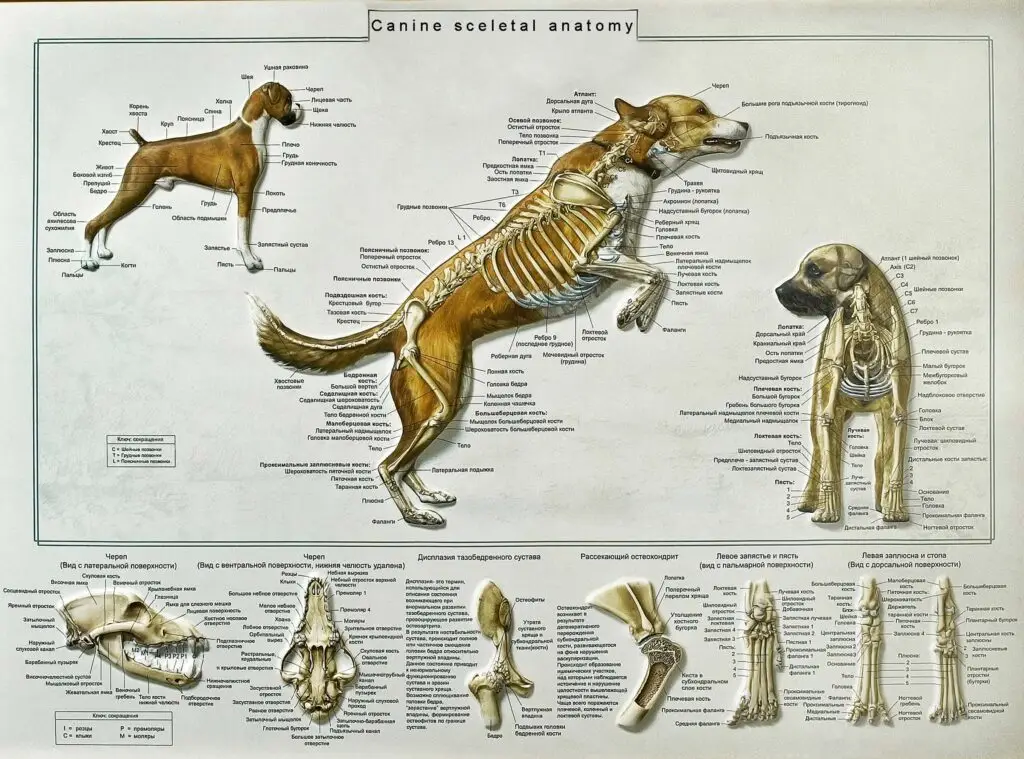At a glance
- Bone Count: Dogs typically have around 320 bones, with variations depending on breed and size.
- Key Components: The skeleton includes essential parts like the skull, vertebral column, rib cage, and limbs, each playing a vital role in support, protection, and movement.
- Unique Features: Dogs possess unique bones such as dewclaws and tail vertebrae, and their paws and limbs are specially adapted for various functions.
- Bone Functions: Bones are crucial for providing structure, facilitating movement, protecting organs, and producing blood cells.
- Common Issues: Awareness of common bone-related issues such as fractures, arthritis, and bone diseases helps in early detection and management.
- Bone Health Maintenance: Proper nutrition, regular exercise, and routine veterinary care are key to maintaining a dog’s bone health.
Did you know that the average dog has more bones than a human? It’s true! Dogs are fascinating creatures with a complex and intricate skeletal system that supports their playful and active lifestyles. Understanding a dog’s skeletal structure not only satisfies our curiosity but also enhances our ability to care for our furry friends, ensuring they remain healthy and robust throughout their lives.
In this blog post, we will dive into the intriguing world of canine anatomy, specifically focusing on the number of bones in a dog’s body. Whether you’re a seasoned dog owner or simply an animal enthusiast, this exploration will provide you with a deeper appreciation of the marvel that is a dog’s skeleton. Let’s embark on this journey to uncover the mysteries of how many bones our loyal companions truly have and what makes their skeletal structure uniquely adapted to their needs.
Table of Contents
Understanding Canine Skeletal Anatomy

Overview of the Dog’s Skeleton
The canine skeleton is a remarkable framework comprised of approximately 320 bones, although this number can vary slightly depending on the breed and size of the dog. This complex structure provides essential support for muscle attachment, protection for vital organs, and movement, allowing dogs to perform a wide range of activities, from running and jumping to digging and playing.
Key Components of the Skeleton
- Skull: The dog’s skull is not only the protector of the brain but also the anchor point for its powerful jaws and teeth. This bony structure varies significantly among breeds, contributing to the diversity in head shapes and sizes observed in different dogs.
- Vertebral Column: Comprising several distinct sections—cervical (neck), thoracic (upper back), lumbar (lower back), sacral (pelvic), and caudal (tail)—the vertebral column provides flexibility and support. The number of vertebrae in the tail can vary, influencing its length and mobility.
- Rib Cage: The rib cage, consisting of 13 pairs of ribs, plays a crucial role in protecting the heart and lungs. This bony structure is designed to be both strong and flexible, allowing for the expansion and contraction needed during breathing.
- Limbs:
- Forelimbs: Each forelimb includes the scapula (shoulder blade), humerus, radius, ulna, carpus (wrist bones), metacarpals, and phalanges (toes). This structure is essential for bearing weight and providing stability.
- Hindlimbs: The hindlimbs consist of the pelvis, femur, patella (kneecap), tibia, fibula, tarsals (ankle bones), metatarsals, and phalanges. These bones are crucial for propulsion and powerful movements.
Unique Features of Dog Bones
Bones Dogs Have That Humans Don’t
- Dewclaws: Dewclaws are small, thumb-like structures located higher up on a dog’s front legs and occasionally on the hind legs. They contain a few bones, including phalanges and a metacarpal or metatarsal bone. These are not present in humans and serve various functions, such as providing extra traction or aiding in gripping objects.
- Tail Vertebrae: Unlike humans, dogs have a tail consisting of additional vertebrae. The number of tail vertebrae varies among breeds, typically ranging from 6 to 23, and contributes to the tail’s length and functionality, which aids in balance and communication.
How Many Bones are in a Dog’s Paw?

- Structure of the Paw: Each paw is a complex structure made up of several bones. In the front paws, there are 5 metacarpal bones and 14 phalanges, with each toe containing 3 bones except for the dewclaw, which has 2. The hind paws are similar, with 4 metatarsal bones and 14 phalanges. This arrangement provides the flexibility and support needed for various movements.
How Many Bones are in a Dog’s Dewclaws?
- Structure and Count: The dewclaw typically contains 2 bones, a proximal phalanx, and a distal phalanx, though the structure may vary slightly between the front and hind legs. These bones are smaller and less developed than the other digits but still play a role in a dog’s anatomy, especially in providing additional stability during certain activities.
Functions of Dog Bones
Support and Structure
- Maintaining Body Shape: The skeletal system provides the fundamental framework that maintains a dog’s body shape and posture. Each bone, from the sturdy femur to the delicate phalanges, contributes to the overall structure, ensuring that dogs can stand, walk, and perform various activities efficiently.
- Protection of Organs: Critical bones such as the rib cage and skull play a vital role in protecting the dog’s vital organs. The rib cage shields the heart and lungs from external injuries, while the skull encases and protects the brain, providing a robust defense against potential threats.
Movement and Locomotion
- Joint Structure: Bones form joints at their connections, which are crucial for movement. These joints, whether hinge-like in the knees or ball-and-socket in the hips, allow for a range of motions, enabling dogs to run, jump, and navigate their environment with agility.
- Muscle Attachment: Bones serve as anchor points for muscles, facilitating movement through the contraction and relaxation of these muscles. This attachment is essential for the powerful and coordinated movements seen in dogs, from sprinting to climbing.
Production of Blood Cells
- Bone Marrow Function: Within many bones lies bone marrow, a vital tissue responsible for producing blood cells. This includes red blood cells, which carry oxygen, white blood cells, which fight infection, and platelets, which aid in blood clotting. This function is critical for maintaining overall health and supporting the dog’s immune system.
Bone Count and Variations
How Many Bones Does a Full-Grown Dog Have?
- Standard Bone Count: On average, a full-grown dog has around 320 bones. This count can fluctuate slightly based on breed and individual differences. The variation is often due to differences in the tail vertebrae and the presence or absence of dewclaws.
- Variations by Breed and Size:
- Breed Factors: Certain breeds, especially those with distinctive physical traits like elongated spines or extra toes (polydactyl breeds), may have more or fewer bones than the average count.
- Size Factors: Larger breeds tend to have more pronounced and robust bones, while smaller breeds have more delicate skeletal structures, though the overall bone count remains relatively consistent.
Largest Bone in a Dog
- Femur: The femur, or thigh bone, is the largest and one of the strongest bones in a dog’s body. It connects to the pelvis at the hip joint and extends down to form the knee joint with the tibia. The femur plays a crucial role in supporting the dog’s weight and facilitating powerful movements such as running and jumping. Its robust structure is essential for the overall stability and strength of the hind limbs.
Detailed Anatomy of Dog Limbs
How Many Fingers Do Dogs Have?
- Paws and Toes: Dogs have a total of 18 toes, with each paw contributing to this count. The front paws typically have 5 toes each, including the dewclaw, while the hind paws usually have 4 toes each. The structure includes:
- Phalanges: The small bones in each toe.
- Metacarpals and Metatarsals: The bones in the main part of the paw that connect to the toes.
This configuration allows dogs to have a firm grip and balance, aiding in their agility and movement.
Comparison to Human Limbs
- Unique Features:
- Flexibility and Function: Dogs’ limbs are uniquely adapted for their lifestyle. Their front limbs (forelimbs) are designed for digging, holding, and bearing weight, while their hind limbs (hindlimbs) are optimized for propulsion and jumping.
- Structural Differences: Unlike humans, dogs walk on their toes (digitigrade posture), which enhances their ability to move quickly and efficiently. This contrasts with humans’ plantigrade posture, where the entire foot touches the ground.
Maintaining Bone Health in Dogs
Nutrition
- Essential Nutrients: Proper bone health in dogs requires a diet rich in essential nutrients, particularly calcium and phosphorus, which are vital for bone development and maintenance. Additionally, vitamins D and K are crucial for calcium absorption and bone metabolism.
- Dietary Recommendations: To ensure optimal bone health:
- Balanced Diet: Feed your dog a balanced diet that includes high-quality commercial dog food formulated to meet all nutritional needs.
- Supplements: Consider supplements only if recommended by a veterinarian, especially for dogs with specific health conditions or dietary restrictions.
Exercise
- Regular Activity: Consistent physical activity is essential for maintaining strong bones and joints. Regular exercise helps to stimulate bone density and improve overall skeletal strength.
- Types of Safe Exercises:
- Walking and Running: Daily walks and runs provide low-impact exercise that strengthens bones.
- Swimming: An excellent low-impact exercise that supports joint health and strengthens muscles without putting stress on bones.
- Fetch and Play: Engaging in games like fetch can provide both physical and mental stimulation, promoting overall health.
Veterinary Care
- Regular Check-Ups: Schedule regular veterinary check-ups to monitor your dog’s bone health and detect any potential issues early. Vets can provide personalized advice based on your dog’s breed, age, and health status.
- Preventive Measures: Implement preventive measures such as:
- Weight Management: Maintain a healthy weight to reduce stress on bones and joints.
- Safe Environment: Ensure a safe living environment to minimize the risk of accidents and injuries that could lead to fractures or joint problems.
Fun Facts About Dog Bones
Unique Features
- Flexibility and Strength: Dog bones are uniquely designed to be both flexible and strong. This combination allows dogs to endure various physical activities, from sprinting to jumping, without compromising the integrity of their skeletal system. The collagen in bones provides flexibility, while calcium phosphate gives them strength.
- Bone Growth and Healing: Dogs’ bones grow and heal in fascinating ways:
- Growth Plates: Puppies have growth plates, soft areas of developing cartilage tissue near the ends of long bones. These plates are crucial for bone growth and close as the dog reaches maturity, solidifying into bone.
- Healing Abilities: Dogs have remarkable healing abilities. When a bone is fractured, new bone tissue forms around the break, eventually remodeling and restoring the bone to its original shape and strength.






